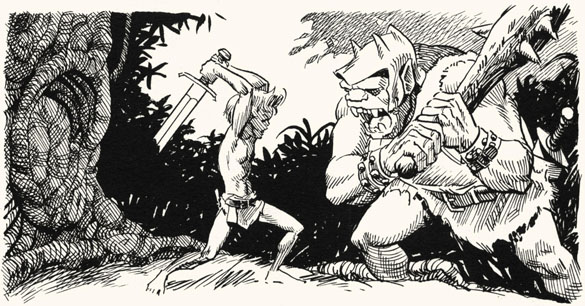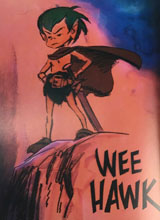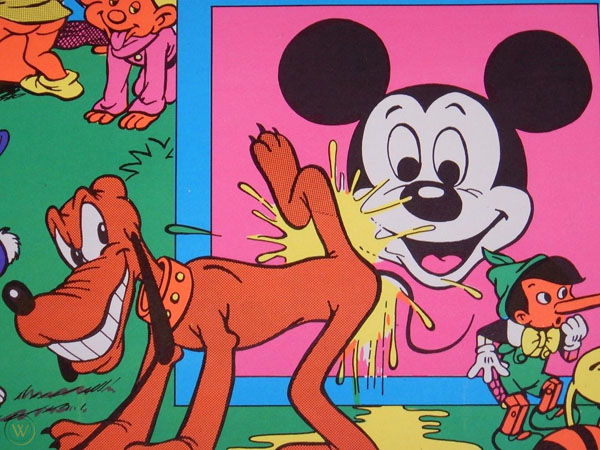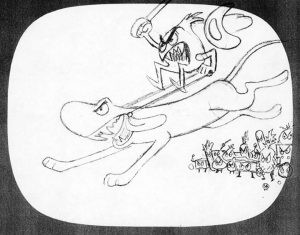Suspended Animation #262

Wood’s Popeye from MAD #72 (July 1962) “If Comic Strip Characters Were as Old As Their Strips”
Wally Wood is well known as a master comic book artist who was equally adept in both realistic and humorous illustration.
Most of his fans know him for his outstanding comic book work from the science fiction classics in EC comics to his comedic cartooning for MAD magazine as well as his own projects including Cannon, Sally Forth, T.H.U.N.D.E.R. Agents and redesigning Marvel’s Daredevil distinctive red costume.
Wood was incredibly prolific. He did work in advertising, gag cartoons for magazines, trading cards, record album covers, science fiction illustrations for magazines and much more.
He also briefly explored animation but unfortunately none of his series proposals were ever produced.

In 1967, Wood did a colorful print magazine ad for Alka-Seltzer entitled “Stomachs get even at night”.
It featured almost a dozen of Wood’s “cartoony” vegetable monsters inside a stomach watching as a clock neared the midnight hour. Then, they plan on a rampage with a cannon, jackhammer and more instruments of pain. “Stomachs get even at night because we are only human during the day” stated the text.
The advertisement won the Art Directors Club Medal that year and garnered a lot of attention. It was so popular that Wood’s obituary in the Los Angeles Times newspaper was headlined “Gut Level Characters Made Him Famous”.
In 1968, Alka-Seltzer decided to transfer that one page full color advertisement into an animated commercial. Wood was hired to sketch the storyboard. The advertisement agency wanted the vegetable characters to do something even though the print ad had just depicted them frozen in that fateful moment before their attack.
For the storyboard, Wood created a human character in striped pajamas sitting on the edge of his bed after winding an alarm clock and then laying down for a good night’s rest.
At the base of the bed, storming over the back board, are a horde of never-ending food monsters who start marching toward the man like an army across a battlefield bed sheet. Wood’s original storyboard showed the monsters exploding from the man’s stomach as he lay in bed but the agency felt that was too violent.
Wood turned in the storyboard but like much of the work-for-hire he did, he cashed the check and never followed up how the final commercial would be handled. His friend and then assistant Bhob Stewart was concerned that Wood didn’t want to be more actively involved to make sure it was animated in his style.
Later, when he saw the finished commercial, he realized what Wood had already known. The agency had diluted it beyond recognition of the original work.
“It’s hard to fall asleep when some of the things you’ve eaten insist on staying up past your bedtime. If there are little things still kicking around, your stomach is going to keep you awake…unless you take Alka-Seltzer,” intoned the narrator in the commercial.
Unfortunately, the sly malevolence in Wood’s character designs had been watered down to look cute and silly rather than forbidding and a genuine threat. They are easily stopped and turned away with a pointed finger after the man takes an Alka-Seltzer tablet.
Wood apparently harbored some personal interest in animation himself and wrote to his friend Richard Pryor (not the comedian but the original comic art collector who produced several portfolios including one featuring Wood’s sexy science fiction artwork): “This may sound wild but I made forty-five seconds of animation on 35mm color film last week. I’m going to do an animated cartoon. I’m going to spend all my spare time for the next year in making some footage. And then see if we can get some backing.”
The project Wood was working on was a concept he had previously pitched to animation studios.
Before he was ten years old, he had conceived of a project known as “King of the World” and later re-titled “The Wizard King”. Wood had immersed himself in Scandinavian folklore and was deeply influenced by the works of Tolkien, in particular The Lord of the Rings trilogy.

“The Wizard King”
Originally, he had planned the project as a fantasy comic book but couldn’t interest a publisher in it. Ralph Bakshi had left Terrytoons for Paramount and began working on animated projects like Jim Steranko’s “Super Agent X” before he started working for Marvel comic books.
Bakshi brought in artists he loved like Gray Morrow and Wally Wood as well as Steranko to help on some projects like layouts, storyboards and other ideas for the television series Rocket Robin Hood. According to one report, Wood worked briefly with Steranko on his “Super Agent X” project and this is when the two artists first met.
 Wood developed his sword-and-sorcery project as an animated cartoon. “Then came Terrytoons where I wrote a story (no money) for a proposed television show I called ‘Wee Hawk’ and did some presentation drawings which they paid for…and then Terrytoons folded. I then went to Paramount, wrote a script, this one I got paid for, and did some presentation drawings…and then Paramount animation folded,” stated Wood in a letter.
Wood developed his sword-and-sorcery project as an animated cartoon. “Then came Terrytoons where I wrote a story (no money) for a proposed television show I called ‘Wee Hawk’ and did some presentation drawings which they paid for…and then Terrytoons folded. I then went to Paramount, wrote a script, this one I got paid for, and did some presentation drawings…and then Paramount animation folded,” stated Wood in a letter.
Several presentation drawings still exist and they show a young hero who is more human in appearance than Wood’s Odkin character who appeared in Wood’s fanzine Witzend but in a similar story situation is accompanied by an older, white mustached companion and a Wood creature with a scruff of hair on top confronting some fantasy menaces.
Wood later complained that many of his characters like “Wee Hawk” and concepts for his animated project were “borrowed” without permission by Ralph Bakshi for his animated film, Wizards (1977). One of the characters in the film is named Wee Hawk.
 Baskhi had stayed in Wood’s home for two weeks going over ideas and producing preliminary sketches for Wood’s project. Bakshi had also borrowed character design and concepts from artist Vaughn Bode as well for Wizards. He has claimed they were meant to be an homage to the artists.
Baskhi had stayed in Wood’s home for two weeks going over ideas and producing preliminary sketches for Wood’s project. Bakshi had also borrowed character design and concepts from artist Vaughn Bode as well for Wizards. He has claimed they were meant to be an homage to the artists.
Cuban-born animator and film producer Pablo Ferro who had made movie trailers and title sequences for major films met Wood in the early 1970s. They began working together to animate some of Wood’s characters like Nudine from “Pipsqueak Papers” that appeared in Witzend. Ferro created character models and layouts using Wood’s original drawings as Wood’s eyesight was beginning to fail due to medical issues.
Ferro also wrote a screenplay on the first volume of The Wizard King under Wood’s supervision but they could never raise the money to go any farther. However, Wood still had other ideas for animated projects and I will cover one of them in two weeks.

And of course Wally Wood had another connection to animation, an infamous one, in 1967 — but that is another tale for another time.



 Jim Korkis is an internationally respected animation historian who in recent years has devoted his attention to the many worlds of Disney. He was a columnist for a variety of animation magazines. With his former writing partner, John Cawley, he authored several animation related books including The Encyclopedia of Cartoon Superstars, How to Create Animation, Cartoon Confidential and Get Animated’s Animation Art Buyer’s Guide. He taught animation classes at the Disney Institute in Florida as well as instructing classes on acting and animation history for Disney Feature Animation: Florida.
Jim Korkis is an internationally respected animation historian who in recent years has devoted his attention to the many worlds of Disney. He was a columnist for a variety of animation magazines. With his former writing partner, John Cawley, he authored several animation related books including The Encyclopedia of Cartoon Superstars, How to Create Animation, Cartoon Confidential and Get Animated’s Animation Art Buyer’s Guide. He taught animation classes at the Disney Institute in Florida as well as instructing classes on acting and animation history for Disney Feature Animation: Florida.




















































“Wee Hawk” is a joke only a New Yorker could laugh at. It’s a pun on Weehawken, a town in New Jersey directly across the Hudson from midtown Manhattan. The Lincoln Tunnel takes you there. High-larious.
On the other hand, the title of Wood’s fanzine witzend (all lower case) is a terribly clever bilingual pun. It not only connotes being at one’s “wit’s end”, but it would mean “joking” in German if “witzen” were a verb, which it’s not. The noun, der Witz, means “joke”.
I remember that Popeye cartoon from MAD magazine! It must have been reprinted in one of the special compilation issues or paperbacks. Funny stuff; but as far as animation is concerned, it seems that Wally Wood was the right man at the wrong time.
Thinking back on your comment about “witzend”, Paul:
Although the term “witzen” is not an actual existing verb in German, the term “witzend” could be the German term for “punch line”, couldn’t it?
Well, no. The German word for “punchline” is die Pointe, one of many modern appropriations from the French. Just as in English you might say “the end of the joke” (das Ende des Witzes), you would never speak of “the joke-end”, which in German I suppose would be either das Witzende or das Witzenende, but definintely not “Witzend”. Good question, though.
That last photo of Pluto showing what he thinks of Mickey is going to be my computers new wallpaper!
Just read that Most Drucker has died, RIP
https://chicago.suntimes.com/entertainment-and-culture/2020/4/9/21215343/mort-drucker-dies-mad-magazine-illustrator-was-91
I am a huge Mort Drucker fan. I wrote about his flirtation with animation in an earlier Animation Anecdotes column.
https://cartoonresearch.com/index.php/animation-anecdotes-260/
There is a strong resemblance between that Alka-Seltzer commercial and the Janet Gaynor film, “Servant’s Entrance”. In the Disney animated sequence from “Servant’s Entrance”, silverware and some food (like an egg), vault over the foot end of Janet’s bedstead and talk with her. Maybe Wood or somebody from the agency were remembering this film as they produced the commercial.
I think that is a great observation and one that no one has ever made before but now it is so obvious. JB Kaufman did a great (as always) column about “Servant’s Entrance” previously at Cartoon Research:
https://cartoonresearch.com/index.php/disneys-servants-entrance-sequence/
What is your source on
“According to one report, Wood worked briefly with Steranko on his “Super Agent X” project and this is when the two artists first met”
???